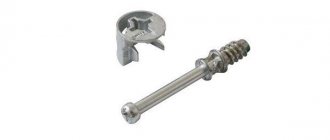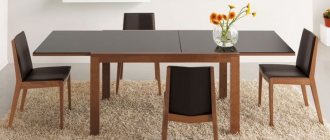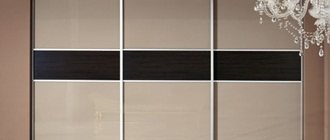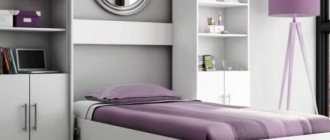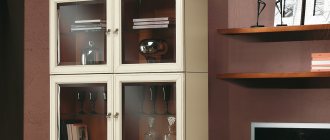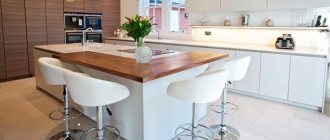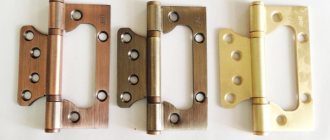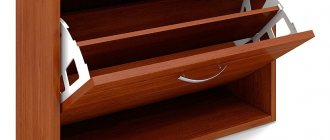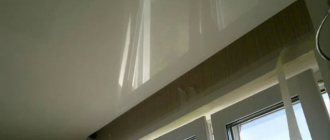Oddly enough, furniture accessories play no less a role than other components of a modern interior: cabinet walls, their doors or shelves. Moreover, the cost of these components (of course, if they are of high quality) makes up a very impressive part of the cost of the furniture produced. This is especially true for kitchens, wardrobes, but, above all, dressing rooms. Even in an ordinary closet you will find many, sometimes inconspicuous, but very useful helpers.
So let's take a closer look at what this capacious concept includes: “ accessories for furniture making .”
Furniture production does not stand alone and this term is found quite often, in different areas of industry and production. The most widely used concepts are “furniture fittings”, “sewing ...” and “window ...”. So what does this term mean?
ACCESSORIES - the totality of all metal and plastic parts in the design of a furniture product, without which its existence is impossible. Furniture components are made of metal and plastic; facial accessories can also be made of wood, glass, and ceramics.
All these elements can be divided into fastening fittings and functional (facial) fittings . This division of accessories is quite arbitrary, because some fasteners can perform the “duties” of the front one.
A special place in this series is furniture edging and edging materials in general (edging tapes, edging glue , etc.). We also note a variety of mortise profiles and furniture edgings. By the way, profiles for finishing furniture edges can also be applied.
Fastening fittings are intended for fastening and fixing parts of cabinets, etc. Fasteners that ensure the movable interaction of furniture elements include various types of hinges, guides, metaboxes, tandemboxes.
| A hinge is a device by which the door is attached to the frame of a furniture product. Hinges are the most important element that ensures the functioning and reliability of a furniture door. The most common are brass or brass-plated hinges (zinc or steel alloys). It is brass-plated on top so that the hinge does not rust and its parts slide better. |
Furniture hinges are often coated with enamel of different colors or other compounds that imitate bronze, gold, or chrome. The very first hinges were probably hinged hinges, then card hinges appeared, and now four-hinged (cup) hinges are mostly used everywhere.
Modern four-hinged hinges , even those produced by the same company, differ in design, variety of purposes and external design. It is pointless to discuss all their features in a short review. Suffice it to say that the catalog of the world's leading manufacturer of four-hinged hinges, the German company Hettich, weighs exactly 4 kg, and the description of hinges of various types and types it contains takes up almost a quarter!
Based on the type of fastening, hinges can be divided into overhead, inset, semi-overlay, and complex hinges .
Overhead hinges are furniture hinges in which the part to be opened completely covers the end of the supporting part and is at an angle of 90° to it.
Inset hinges are furniture hinges in which the outer plane of the part to be opened is at an angle of 90° to the supporting part and in the same plane as its end.
Semi-overlay hinges - this type of furniture hinge is used when two opposite hinges are installed on one load-bearing part, while the parts to be opened cover the end of the load-bearing part (each by an equal half depending on the model of the hinge used) and are also at an angle of 90 ° to her.
Complex hinges are furniture hinges in which the angle of rotation when opening can be +-45°, +-30°, 180° and differs from the standard opening angle of 95-110°.
Furniture guides
Guides are a drawer pull-out system. All extension systems can be divided into two types: - guides for ordinary drawers made of chipboard or wood; - boxes with metal parts in their design (sides, sometimes backs)
Roller and ball guides are now widely used.
| Roller drawers are easy to use and, when installed correctly, make it easy to open and close drawers. |
| Ball guides are high-tech, varied, and vary in complexity. They allow the drawers to be fully extended, provide smooth running and silent soft closing of the drawers. |
| Metaboxes are sidewalls for economy class boxes. Metaboxes are made on the basis of roller guides, but have serious differences. The metabox set consists of two support guides (left and right) and two guides, which are also the side walls of the box (left and right). This is one of the conveniences of metaboxes, because... there is no need to make the side walls of the box from chipboard or other material. You only need to make the bottom, back wall and front of the box of the required size. |
And the fact that the bottom is made of laminated chipboard (mostly the thickness of laminated chipboard is 16mm), and not from fiberboard (mostly the thickness of fibreboard is 4mm), gives the product extraordinary strength and reliability. Another advantage of metaboxes is the fastenings for the facade, which are adjustable, ensuring that the front of the box is installed exactly on the body of the furniture. There are also special extension bars for metaboxes that allow you to increase the working height of the metabox to the desired size, and separation systems will allow you to properly organize the workspace inside the metabox itself. Metaboxes are made of steel, 1.2mm thick and coated with high-strength enamel in various colors (mainly white and metallic).
The material of the rollers themselves is high-strength plastic , designed for more than one thousand openings. The load (weight of the box) supported by metaboxes directly depends on their length. The longer the length, the less the load: from 10kg to 20kg. (open state). Metaboxes are considered a partial extension system (3/4), i.e. extend three-quarters of their total length. Metaboxes can be used for both overlay and inset facades.
| Tandemboxes are a high-tech mechanism for drawing out drawers. The tandembox is equipped with a maintenance-free guide system that is hidden from view under other parts and is highly resistant to lateral loads. The high-quality drawer pull-out system has excellent movement, easily pulls drawers into the cabinet, and is equipped with a lock that prevents them from being unintentionally left in the extended position (important for the safety of children). The guide system requires no maintenance and is highly wear-resistant. It leaves no traces of metal abrasion or any other contaminants: cleanliness and hygiene are guaranteed! Maximum load - 30kg. |
Furniture fasteners
Fasteners screws , confirmations, dowels, screws, corners, etc. Moreover, all these listed fasteners belong to the group of screeds, but they are called differently.
If we take the origins of furniture, then at the beginning of carpentry there was no such variety of fasteners as there is now, and all furniture was built on locking joints, tenons, “dowels” (now dowels) and wedges, which gave strength to benches and tables. Since then, a lot has changed, but the dowel has remained the fastener still used today. The dowels (8X30), however, also acquired different sizes, received corrugation and a precise chamfer at the ends. Everything else gave way to special fittings.
| Connecting furniture on dowels even now gives us the opportunity to quickly and correctly position furniture parts during assembly, and prevents their mutual displacement during operation, absorbing all lateral loads. A dowel is a very cheap and simple part, but it also has its own difficulties. |
It is made from natural wood and, when made from undried wood or improperly stored, can change its cylindrical shape, which significantly affects the quality of the connection. However, small furniture is connected using dowels alone. With large product sizes and correspondingly increasing loads, the dowels can no longer withstand pulling out, that is, longitudinal forces, and therefore, ties can always be found next to them.
| A screw tie or barrel tie consists of only two elements: a screw and a “barrel” - a cylindrical part with a transverse threaded hole. The “barrel” itself is made entirely of metal or plastic with a nut inserted inside (however, its diameter increases somewhat). The tie is very strong, since when tightening the screw, very large forces are generated and a long tightening stroke is generated, but visible screw heads always appear on the side surface of the product, spoiling its appearance. Of course, the head of the screw, especially with a hex slot, can be covered with a plastic plug, but the appearance will still leave much to be desired. |
The screed is not very easy to assemble. The hole in the barrel must line up exactly with the screw. Therefore, the mutually perpendicular axes of the holes for the “barrel” and for the screw in the plate and the end of the part must intersect exactly. When the installed “barrel” is simply turned the wrong way, it is easy to turn it around using a specially provided slot at the end. But if the hole under it is too deep, and he simply “drowned” in it, it is extremely difficult to pull him back out.
| Conical coupler . The desire to hide the screw head from the front surface led to the modernization of the “barrel” coupler. As a result, the screw passing through the attached part of the assembled furniture frame was replaced by a rod screwed into a body with a threaded hole, screwed or pressed flush into the face of the part. |
Two holes are drilled in the main part: one at the end, for the rod, the other, perpendicular to the first, in the face, for the “barrel”. The rod, at the end of which a conical recess is formed on the side surface, passes through the transverse hole of the body, along the axis of which there is a threaded hole with a screw. The tip of the screw has a pointed conical shape and when the screw is screwed in, it rests on the side surface of the recess of the tie rod, displacing it together with the attached part to the end of the main one, which is what achieves tension in the connection.
| Screed furniture corner . The product is also very simple in design: a strip of metal bent at a right angle with a hole on one arm and a groove on the other. It consists entirely of five elements: an angle, two countersunk screws and two threaded fittings. During assembly, the angle is attached with screws to the parts being connected using metal or plastic fittings with an internal threaded hole. |
The tightening force is achieved by displacing the axis of the fastening hole on one of the parts being connected. As a result, when screwing the screw, it presses with the cone of its head on the conical side surface of the hole in the corner, displacing the entire attached part and attracting it. At one time, this screed even became predominantly widespread in our industry, because: it is durable; does not require drilling holes in the ends; easy to install; unpretentious to the accuracy of the location of filler holes; Disadvantages: visible; interferes with the use of furniture; there are a lot of defects in its production; As for attempts to use metal or plastic corners secured with screws to connect furniture parts, it is better not to buy furniture with such joints: this is not a screed at all, and it is impossible to obtain a reliable tense corner joint in any furniture with their help.
| Screw tie , or euroscrew , or euroscrew , or confirmat screw, is usually made of carbon steel. In Europe this tie is called "Einteilferbinder" or "single element tie". And for some reason we call it a “euroscrew” or “euroscrew”. Although the name “screw tie” is much more suitable for it, especially since it is like two drops of water like a screw, only thick and blunt. |
Depending on the manufacturer, as well as the specifics of production, confirmations have different coatings : electro-galvanized, brass-plated, nickel, about 5 mm thick. The simplest screed, which has found such wide use among our furniture makers precisely because it does not require practically any precision at all when adding.
Only two holes are drilled: one in the end of the main part, the other in the face attached to it. The most popular are Euroscrews with a thread diameter of 7mm and a length of 50 or 70mm. Screeds from different manufacturers have their own design features. The small diameter of the head often allows, using force, to embed the screed flush with the surface of the slab without first countersinking the hole. Also, screw ties may have a specially provided “tooth” under the head, similar to a flash in a poorly made nail, which ensures that it is screwed in flush without countersinking, forming a chamfer for the hole.
A high-quality screed should not have a displacement of the head or slot relative to the axis. If this alignment does not exist, then the tie will go unevenly when screwed in, and the thread will break the hole, which impairs the strength of the connection between the chipboard parts. A tie with a smaller pitch of turns and a larger thread point provides a more durable connection. The first four turns of the thread are conical and have special serrations.
Therefore, the tie works like a tap or self-tapping screw, ensuring the cutting of smooth, high-quality threads to accommodate the remaining turns without disturbing the structure of the slab. Disadvantages: head visible from the end. It is usually closed with a plug; furniture assembled on such a screed cannot be assembled more than three times, since the threads cut in such a soft material as chipboard are likely to break. The trouble is that many manufacturers, rightly hoping for the strength of the metal, have completely stopped using dowels together with this screed. But if the assembly is carried out without securing the parts in the clamp, then the parts may “lead away”, which can be noticeable when inspecting some products.
| An eccentric coupler is a type of connecting fittings that combines low-visibility and high connection strength and provides the possibility of repeated assembly of the product. Ties from different manufacturers have their own characteristics, and because of their characteristics, eccentric couplers are also called minifixes, rondofixes and raffixes - these words are derived from the names of eccentric couplers from different manufacturers. |
The principle of operation of the tie : A metal or plastic sleeve is screwed or pressed into the face of the attached part, flush with it, into which the tie rod with a “T”-shaped head is screwed. When assembling the product, the rod passes through a hole in the end of the main part, and its head ends up in the middle of a transverse hole drilled in its face. An eccentric is installed in it, gripping the rod head with its internal eccentric surface. With further rotation, the eccentric, turning in its hole and acting on the head of the rod, first brings the parts to be connected together, and then creates the necessary force in the connection.
An eccentric coupler consists of a cast metal eccentric, a fitting and a rod. There are also quite a lot of designs of such couplers, in which the rod is wrapped directly into the material of the attached part, without the use of a sleeve. The main difference between eccentric couplers is the diameter of the eccentric. The larger it is, the greater the stroke of the tie and the greater the possible force. Eccentrics with a diameter of 25, 15 and 12 mm are used.
Eccentrics with a diameter of 25 mm, and sometimes 15 mm, must be closed with a plastic plug. Disadvantages: possible weakening of the tie during use of the product. Different manufacturers solve this problem in different ways. For some couplers, the internal working surface of the eccentric is made concave, and the spherical working surface of the rod head is in contact with it. In other designs, the internal working surface of the eccentric is stepped, and the adjacent working surface of the rod head is flat.
In this case, the outer surface of the eccentric is equipped with oblique smoothed teeth, inclined in the direction opposite to the direction of its rotation during assembly, which, while increasing adhesion to the material of the part, additionally prevents its spontaneous rotation and weakening of the connection during operation of the product. Also, the notches inside the eccentric increase its grip on the rod three times compared to a smooth flat surface. An eccentric coupler requires extremely precise relative positioning of all mating holes. Drilling these holes “on the knee” often leads to breakage of the eccentric when applying force during assembly. Actually, the lack of precise filler equipment limits the widespread use of eccentric couplers in domestic furniture.
| Screw (derived from the German Schraube) is a screw driven into wood or other soft material, in which the screw itself forms a thread by deforming the material. The screw can be screwed into any material due to the threads that are made on the screw shaft. The thread of a screw is different from the thread of screws and bolts screwed into metal. It is taller and has a larger cutting pitch. |
The threaded portion of the screw has a conical shape, tapering towards the end of the screw. The thread can be cut either along the entire length or only on part of the screw. The sizes of screws also vary depending on the tasks that are solved with their help.
| Self -tapping screws are fasteners in shape that correspond to the definition of a SCREW, but with significant design improvements (primarily the shape of the thread, tip and slot), made of high-quality materials with various corrosion-resistant and aesthetic coatings. |
These improvements make it possible to frequently use screws without pre-drilling holes (which significantly simplifies and speeds up the installation process of fastened products), as well as to use screws for fastenings on a metal (aluminum, steel, etc.) base and in building materials (concrete, brick, etc.). P.). Such screws have significantly expanded the scope of their application and have significantly influenced the technology of many construction and mechanical assembly works.
Since the new screws were radically different from the traditional ones, a new term appeared in everyday life - SCREWS. This concept more accurately shows the purpose and capabilities of new screws, although today it is not legalized by the corresponding standard.
Components and parts for furniture products: general information
Furniture fittings today include dozens of products that can make the work of craftsmen in assembling finished furnishings much easier. Unlike nails or ordinary screws, modern solutions look presentable. The quality of the fittings, guaranteed by the manufacturers, allows us to provide reliable:
- threaded connection consisting of screws and nuts (possibly an addition in the form of a washer)
- screw connection - it is created by a euroscrew or confirmat
- forming a screed - using eccentrics, hidden type of fastening
- connection using corners and dowels
Furniture components are selected based on the type of its design and purpose. Walls and racks are assembled using ties. Metal fittings for kitchen furniture may include guides, closers, and elevators. Suitable components are selected at the drawing development stage.
Furniture components are accessories that ensure high speed of installation. For natural wood or composite materials, different types of fastenings are used. Correctly selected fittings for chipboard or MDF can extend the life of furniture.
Shelf holders or shelf supports
Shelf supports are a piece of hardware that holds a shelf. The purpose of this fittings is to firmly hold all shelves at the desired height. A shelf installed on shelf holders between two vertical walls of the product at a high level, regardless of the design of the shelf holder, must be protected from accidental overturning under the influence of a load on its front edge. Therefore, shelf holders should be located at a distance of no more than 50-60mm from the front edge of the shelf. The main models of modern shelf holders are shelf holders for glass surfaces and chipboards, decorative and hidden, special shelf holders combined with ties, shelf holders for quick types of installation and many others.
Functional (or front) fittings are visible fasteners that carry a certain functional load. Facial fittings ensure interaction between the product and the person. Functional fittings include furniture supports, handles, sliding systems, wardrobe equipment, and kitchen accessories.
A handle is an object or part of it specially designed for grasping, grasping or pressing with the hand when performing some short-term action, for example, for opening something: the handle of a door, window, cabinet drawer, etc.
In the design of furniture, several types of handles are used, depending on their shape, which have received independent names: handles-buttons, handles-bars, handles-sinks and handles-brackets (handle-brace) and so-called handles-rails . Handles are made, as a rule, in three stylistic directions: classic, retro, modern design. In most cases, handles are made of metal, but there are handles made of plastic, glass and ceramics.
A button handle has a round, rectangular or other shaped body, attached to the furniture with a screw passing through its axis. Knob handles, if necessary, are equipped with devices that prevent them from freely turning or unscrewing under normal operating conditions.
The handle bar is attached to the furniture at at least two points. Its body, most often, has a cross-section that is constant along its entire length.
Shell handles can be either protruding above the surface of the element to which they are attached, or recessed, embedded in the product. Protruding handles are attached to the product at two points, while recessed handles are inserted into the hole chosen for them.
Bracket handles have a fixed or movable through bracket fixed at two points. Handle rails are a chrome-plated steel rod with two attachment points. Handle rails are a fashion option and, as a rule, exceed the size of handle bars.
Handles are attached to furniture using glue, screws and screws. Fastening with glue is rarely used, since glued handles cannot be removed from the product, which may be required during transportation and repair. In addition, glued handles are difficult to replace with new ones. Mostly recessed handles-shells are placed on the glue. Today, a common method of fastening handles is with special screws embedded in the handle during its manufacture, and standard nuts. The nut and screw are closed with a metal or plastic cap.
How to choose the right fittings
The process of choosing the right fittings is not as simple as it might seem. The following points need to be taken into account:
- ease of installation;
- functionality;
- design.
For example, some fastenings for furniture fittings require drilling grooves in the wood. To carry out this process, you need a special cutter. In its absence, the installation process will be quite difficult.
Ease of use should also be taken into account. Door fittings are constantly used - they are always in front of the eyes and a person touches them with his hand, so it is necessary to select handles and similar elements taking into account the color scheme of the furniture itself.
Choosing accessories for chairs
The choice of accessories for chairs must be made taking into account the weight of the person using it, since in most cases such products act as a supporting structure. That is why, first of all, you should pay attention to the material from which the chair fittings are made. The optimal solution in this case is steel.
It is worth purchasing products only from well-known brands. Many unscrupulous manufacturers make devices of this type from silumin and other similar materials that have low strength. This also applies to various types of wheels for chairs and other similar items.
Support structure for office chair
Selection of fittings for cabinet furniture
The cabinet type of furniture is gaining increasing popularity due to the ease of its assembly, as well as the presence of other important advantages. It is used both in office premises and at home. Fittings for cabinet furniture must have the following important qualities:
- strength;
- simplicity of the device;
- security.
Many components of cabinet furniture are quite heavy, so all fittings used for assembly must be strong enough. Often this type of furniture is made partly or even entirely from glass. That is why, when choosing, you should pay attention to the presence of special silicone or rubber gaskets. Direct contact between metal and glass is always best avoided.
Various types of fittings for cabinet furniture
Accessories for sashes
High-quality fittings for furniture doors are very important. Since this mechanism carries maximum loads during the operation of the doors. It contains many surfaces that come into contact with each other during use, causing friction. This significantly accelerates the wear of the mechanism.
The second reason why you should purchase only the most durable mechanisms of the type in question is the threat of sagging. Many furniture is made from wood, which has a very high density. That is why it is necessary to pay great attention to the material of manufacture - if it is not strong enough, the sash can quickly sag. Moreover, often not only the fittings themselves are damaged, but also the sash - when used in a “sagging” state, it clings to other surfaces.
Accessories for furniture doors
Guides for chests of drawers and other furniture with drawers
It happens that for some reason special guides are not included with a chest of drawers or other similar furniture. In this case, you have to purchase and install them yourself. Dresser guides purchased independently must:
- fit the overall dimensions;
- be strong enough to support the weight of the box;
- have a simple fastening.
It is best to focus your attention on the fittings for the chest of drawers, equipped with special screws, screws or other items that allow installation. In most cases, this will simplify the installation task. It is also worthwhile to first measure the installation location in the furniture - this way you can avoid the need to adjust the purchased fittings.
Guide fittings for chests of drawers and other similar furniture
